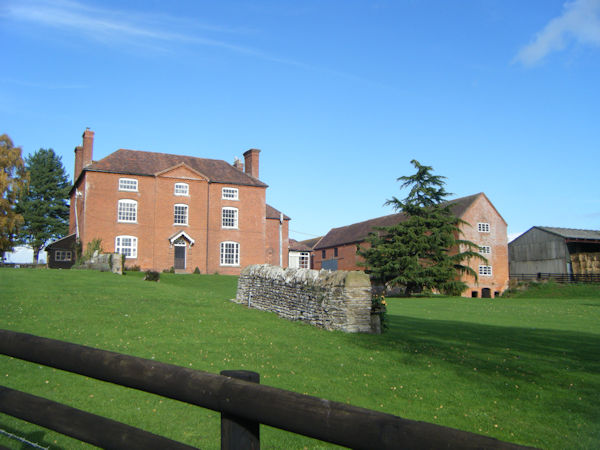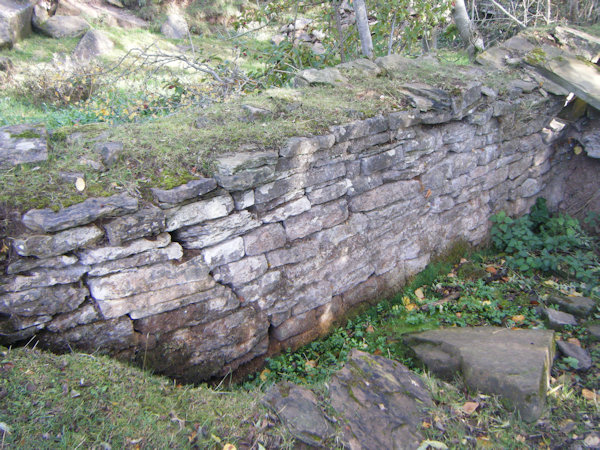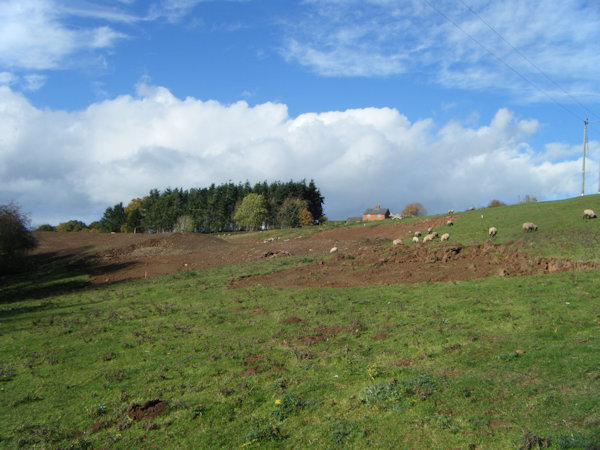 |
 |
 |
 |
 |
HOME - ENGLAND - HEREFORDSHIRE
Dedication: Saint Catherine of Ledbury Location: (near) Burton Court Status: lost |
St Catherine of Ledbury, or "Katharine Audley", as she was known during her lifetime, is quite a mysterious medieval figure. According to a local legend that was recorded by Sabine Baring-Gould in his Lives of the Saints, in 1898, Catherine was "a holy woman" who travelled across the country, with her maid "Mabel", in search of a place where "she had heard the [church] bells ring of themselves", something which reputedly occurred at Ledbury upon Catherine's arrival. She is said to have remained here as an anchoress for many years, living "upon milk and herbs" and an "annuity of £30" that was allegedly sent to her on the orders of the King. It is interesting to note that £30 at this time would have been roughly equivalent to just less than £30,000 today, which, as Baring-Gould pointed out himself, is not the sort of annual allowance that an ordinary anchoress had access to, or ever needed.
Indeed, there is much more to the life of the real Katharine Audley than the Ledbury legend reports. She was born the daughter of a wealthy baron, named John Giffard, at some point during the 13th century, and, after the death of her husband in the late 13th or very early 14th century, inherited a large estate and fortune. The extent of her subsequent power is evidenced in an enrolment of a grant from the sixth regnal year of King Edward II, 1312 to 1313, in which Audley granted "the castle and town of Thlanandevery [sic] in Wales", the commotes "of Hirnirn" and "of Pervet", including "all appurtenances of the castle, town, and commotes", to her daughter Ela, and her husband "James de Perrers". Intriguingly, this document, a description of which appears in the Calendar of the Close Rolls Preserved in the Public Record Office (1893), was dated "at Ledebury [sic]", and witnessed by the then Bishop of Hereford, Richard Swinefield, and the Vicar of "Ledebury", among others. It seems that Audley had already chosen Ledbury as the place of her anchorhold, and was now signing off responsibility for her estates and wealth to her descendants. In particular, it is very interesting that the Bishop of Hereford was present when the document was signed: as the local bishop was often responsible for new anchorites, it is possible that this was the day on which Audley officially became an anchoress. The document was composed on the "Monday before St. Nicholas the Confessor", whose feast was held on the 10th of September.
Of course, the yearly allowance that, according to legend, Audley received from the King suggests that she did not lose all of her power when she became an anchoress. In fact, this part of the legend does appear to be true, because in the Close Rolls from the 17th regnal year of Edward II (1323 or 1324), by which time Katharine had been an anchoress for at least a decade, reference is made to a certain amount of money being given to "Katharine de Audele, reclusa de Ledebury", described as "dilecta nobis in Christo" ("beloved to us in Christ"), "yearly for her maintenance". This document, according to the Calendar of the Close Rolls (1898) takes the form of an order sent to a man named "John Wroth", said to be "keeper of the manors" that Audley once owned, "to pay" her "30l.", "the king having granted her that sum yearly". Although it is unclear why exactly Audley needed such a large allowance each year, it seems probable from the legend that she would have kept at least one servant (perhaps "Mabel") with her during her time in the anchorhold, and must have enjoyed other additional luxuries.
I have been unable to find a record of when exactly she died, but her feast day, according to Sabine Baring-Gould, was the 25th of November, so it is possible that she died on or around that date. Either way, it is very likely that she died, and was buried at, Ledbury Church, where a shrine is rumoured to have been constructed in her memory, in the hope that a cult would develop around her. Her medieval cult certainly did develop in the vicinity, although it did not gain true popularity, and there is considerable evidence to suggest that she simply replaced an earlier local cult of St Catherine of Alexandria. A prime example of this happening can be seen in the documented change in the dedication of Ledbury's medieval Hospital of St Catherine, which was founded, according to Dugdale's Monasticon Anglicanum (1718), by "Hugh Foliot, Biſhop of Hereford", and initially placed "under the Invocation of St. Catherine, Virgin" (this being St Catherine of Alexandria). Sabine Baring-Gould confirms this in his statement that it was established "in 1232", during which time Foliot was Bishop, almost a century before Katharine Audley arrived in Ledbury. However, the institution had become known as the "Hospital of St Catherine of Ledbury" by the Reformation.
This is not the only way in which St Catherine of Ledbury's local cult manifested itself: St Catherine's Well at Stretton Grandison, nearby, and the associated "St Catherine's Tree" were both reputedly dedicated to the saint, and her name was known throughout the locality into the early 19th century. However, the most intriguing legend of all that Catherine is associated with is that of her colt and mare, which was recounted by Jabez Allies in 1835, as part of his Observations on Certain Curious Indentations in the Old Red Sandstone of Worcestershire and Herefordshire:
|
The legendary story I heard from my late father William Allies, of Upper House, Alfrick, relative to these remarkable tracks, as near as I can recollect, was this. A person, said to be a girl with a pair of pattens on, having stolen Saint Catherine's Mare and Colt, and led them down several brooks to avoid detection - the Saint upon being informed of her loss, prayed that wherever the animals and thief trod, the marks of their feet might be left; and that in answer to this prayer, the prints of the animals' feet, and also of the patten rings were deeply indented, not only in the earth, but also in the stones wherever they trod, and that thereby they were traced to, and found at Ledbury. He also told me that in his juvenile days, some of the mare's tracks in Sapey Brook, contained what he considered to be the prints of the nails, and of the cockers in her shoes; and Mr. James Cowcher, formerly of Woodmanton, and now of Alfrick, has lately informed me that he, when young, frequently saw such tracks of the mare and colt in the stones in Sapey Brook, in several places, on both large and small stones... |
Allies became fascinated with the indentations in the stones of Sapey Brook, and was determined to work out what had caused them. As part of the research that he published in his aforementioned book in 1835, he spoke to a large number of people from the locality who were well acquainted with the legend, including a "Mr. Richard Heming, of Kingsland, near Leominster", who knew of the story because he originally lived in "Sivington", and an anonymous "elderly person" who lived at "Pauncefort's Court, in Much Cowarne, Herefordshire", where remembrance of the tale was apparently very strong. Apart from the fact that this shows the spread of St Catherine's cult after her death, it also suggests that legends involving St Catherine were very strong locally during the medieval period. Indeed, on an expedition to Sapey Brook on "the 19th of June, 1834", Allies met yet another person who was aware of a different tale associated directly with Sapey, and who guided him to the Holy Well:
|
...[I] requested Dr. Field, one of the council of our Society, and Mr. Lees, to accompany me to Sapey Brook to ascertain whether any of the tracks were still to be seen there, and after taking a circuit to examine that remarkable mass of calcareous incrustations called Southstones, or Southern's Rock, near Stanford Court, we walked along the whole course of the brook from its commencement in Upper Sapey, and through Lower Sapey, into Tedstone Delamere; and a person residing in the neighbourhood informed us, that tracks were still to be seen in the brook, and that he had known them for several years, and he undertook to conduct us to them. He said the report is, that Saint Catherine lived at the farm house called Burton, in which Mr. Walker now resides, situated on the west side of the brook in Lower Sapey, and that the mare and colt were stolen from thence, and led down the brook to avoid detection, and on to Ledbury; and he first conducted us to a small spring on the same side of the brook, called the Holy Well; and about half a mile further down, and a little below the Hope Mill, we were shewn a stone in the channel of the brook containing several very distinct tracks, namely two called those of the mare, three of the colt, one rather doubtful track, [and] one patten ring impression... |
Allies' description makes it clear that this "Holy Well" was located somewhere beside Sapey Brook, between "Burton", and "Hope Mill". Looking on historic Ordnance Survey maps for the area, I have been able to locate both the Hope Mill, at SO6972360851, and a farm house named "Burton Court", which must be the "Burton" that Allies was referring to, at SO6945462114. A slight problem with this is that Allies described Burton Court as being "on the west side of the brook", when it is actually on the northern side of Sapey Brook, but this is most probably down to him mixing up his directions, which would be unsurprising given that OS maps had not yet been created.
Whatever the reason, this house is certainly "the farm house called Burton", where St Catherine reputedly lived for some time, because I have found multiple references to a "Mr. Walker, of Burton Court" from the very early 19th century. Perhaps most notably, his name appears in Eyton's Herd Book of Hereford Cattle (1846), in which he is recorded as having bought a cow named "THE GENERAL" in 1841, for the sum of £55. In 1808, The Monthly Magazine also reported that "Mr. Walker, of Burton-court" had won the prize of "best boar" at the "late annual meeting of the Herefordshire Agricultural Society at Leominster". This, of course, matches up with Allies' statement that Burton court was the residence of "Mr. Walker".
Locating the spring itself is simplified by the fact that no Ordnance Survey maps, historic or otherwise, mark any springs or watersources along the entire stretch of the stream between Burton Court and Hope Mill, except for in one place: in a field just beneath Burton Court. Both historic and modern OS maps depict three water sources in close proximity in this field, one of which must have been the Holy Well seen by Allies:
An un-named spring located at SO6926762061, roughly in the centre of the field, that was shown on all historic Ordnance Survey maps, dating back as early as 1884.
Another anonymous watersource located just to the east, at SO6930162004, which first appeared on the 1904 25-inch OS map of the area, and has been marked on all subsequent editions.
A very large pool or pond (apparently spring-fed, according to the maps) situated on the far eastern side of the field, directly beside a public footpath that leads from the brook to the farm, at SO6937261941. This is the most likely candidate, simply because of its location next to a footpath, and the fact that it is a prominent feature in the field. It has always been marked on Ordnance Survey maps.
In November 2025, I visited Burton Court with the intention of inspecting all three potential sites. Despite the fact that the three sources are all marked on current OS maps (at least at the time of writing), I found that only the large pool or pond still existed. The other two springs appeared to have been drained at some point, and all that remained of both was a pair of dry gullies leading down the slope, and terminating at the edge of Sapey Brook. The draining of these two springs is almost certainly a recent occurrence, as at least half of the field seemed to be in the process of being landscaped. Nevertheless, the large pond or pool at SO6937261941 was still in existence, although the spring was evidently much weaker than it once was, perhaps as a result of the disturbances. I was surprised to find that it takes the form of a large oval, around twenty metres across, walled (or possibly dammed) on one side by an old dry stone wall, and faced on the other by a grassy bank, and some large boulders. Because of its prominence, and position beside a public footpath, this is definitely the most likely candidate.
Although I have not been able to find any more information explicitly regarding a "Holy Well" near Burton Court, I have come across a number of references to a well of St Catherine existing at Sapey in the early 19th century, and, because Burton Court was undoubtedly the centre of the saint's cult in the parish, this well was almost certainly the same as the one seen by Jabez Allies in 1834. For example, in that very same year, Charles Hastings wrote in his Illustrations of the Natural History of Worcestershire that the plant "Aspidium (Athyrium) Filix-foemina" had been spotted at "St. Catherine's Well, Sapey". Similarly, an 1836 edition of The Magazine of Botany, Gardening and Agriculture attests that "Ribes rubrum" had been found "in a ravine at Clifton-on-Teme, between that place and St. Catherine's Well". This last remark is particularly interesting, because Ordnance Survey maps do mark a "ravine" roughly half-way between Burton Court and Clifton-on-Teme, which suggests that the Holy Well at Burton was the one being referred to here.
 |
 |
 |
 |
 |
Images:
Old OS maps are reproduced with the permission of the National Library of Scotland
Copyright 2025 britishholywells.co.uk